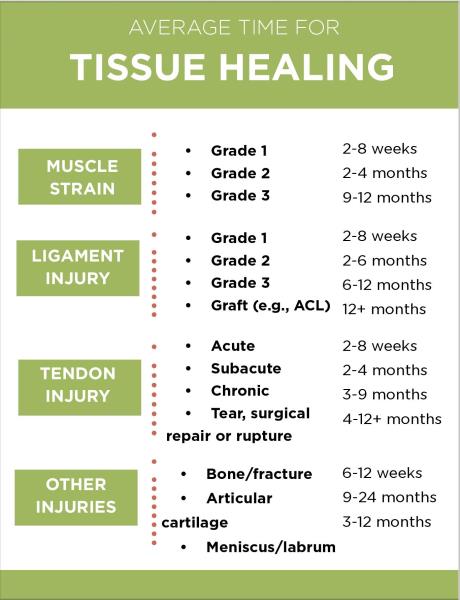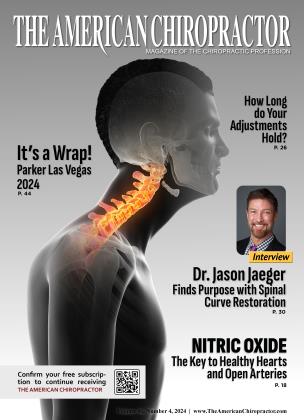Be Patient with Your Patients
By Eric Kaplan, DC, FIAMA, Perry Bard, DC, & Jason Kaplan, DC
Doctors, we believe one of the biggest mistakes that chiropractors make is not explaining to their patients that healing takes time. Chiropractors sometimes get caught up with what I believe is “Harvey Lillard” syndrome, i.e., they expect to change the patient’s health and cure the patient on any given visit.
Yes, miracles do happen in our beautiful profession. However, even the miracle of birth takes nine months, and the miracle of a child walking might take nine months to a year.
The body is an amazing instrument, but it needs time to heal after injury. Most patients go back to their daily routine as soon as possible because we do not emphasize the process of time. Our primary job is to control and contain — to prevent the patient from having back surgery and to give them relief.
When an injury occurs, the initial phase is always an outpouring of lymphatic fluid and blood. During this process, adequate hemostasis is achieved. Both the extrinsic and intrinsic coagulation pathways are activated and play a role in stopping blood loss.
Aggregation of platelets follows the arterial vasoconstriction to the damaged endothelial lining. The release of adenosine 5’-diphosphate (ADP) results in the clumping of platelets and initiates the process of thrombosis. This vasoconstriction is a short-lived process that is soon followed by vasodilation, which allows the influx of white cells and more thrombocytes. Laser, matrix, and shockwave stimulate ADP, which is germane in the healing process.
The inflammatory phase begins with hemostasis and chemotaxis. White cells and thrombocytes speed up the inflammatory process by releasing more mediators and cytokines. Besides the platelet-derived growth factor, other factors promote collagen degradation, the transformation of fibroblasts, the growth of new vessels, and re-epithelialization. All of these processes occur at the same time in a synchronized fashion.
Mediators like serotonin and histamine are released from platelets and increase cellular permeability. The platelet-derived growth factor attracts fibroblasts and, along with transforming growth factor, enhances the division and multiplication of fibroblasts. The fibroblasts, in turn, synthesize collagen.
Inflammatory cells, such as neutrophils, monocytes, and endothelial cells, adhere to a fibrin scaffold formed by platelet activation. Neutrophils enable phagocytosis of cellular debris and bacteria, allowing for decontamination of the wound.4 The proliferative or granulation phase does not occur at a discrete time but is ongoing in the background.
Five to seven days after an injury, the fibroblasts have started to lay down new collagen and glycosaminoglycans. These proteoglycans form the core of the wound and help stabilize it. Then, re-epithelialization starts to occur with the migration of cells from the wound periphery and adjacent edges.
Initially, only a thin superficial layer of epithelial cells is laid down, but a thicker and more durable layer of cells will bridge the wound over time. Next, neovascularization occurs through both angiogenesis (forming new blood vessels from existing vessels) and vasculogenesis (formation of new vessels from endothelial progenitor cells, or EPCs). Once collagen fibers have been laid down on the fibrin framework, the wound starts to mature. The wound also begins to contract and is facilitated by continued deposition of fibroblasts and myofibroblasts.

The maturational or remodeling phase starts around week three and can last up to 12 months. The excess collagen degrades, and wound contraction begins to peak around week three. Wound contraction occurs to a much greater extent in secondary healing than in primary healing. The maximal tensile strength of the incision wound occurs after about 11 to 14 weeks. The ultimate resulting scar will never have 100% of the original strength of the wound and only about 80% of the tensile strength.
As you look at the four phases, you must look at phases three and four. Where did the disc go? How much pain was the patient in during this process? Were they treated properly and appropriately for a disc injury? Reconstruction may take years. It seems that dentists and orthodontists understand that tissue healing takes time. You must understand that as we adjust bones, tissue must remodel, which takes time.
Recovery Timeline for Tissue Types
Tissues are also composed of different materials, so they do not all have the same healing time. Tissues are categorized as muscle, tendon, ligament, and bone, and each tissue is comprised of collagen, elastin, proteoglycans, and cells. Each tissue has specific properties — strength, extensibility (ability to stretch), elasticity (ability to recoil once stretched), and overall structure. Furthermore, knowing what type of tissue is injured is essential to appropriately estimate a time for healing and set appropriate rehabilitation expectations.
The three tissue types are:
1. Muscle
Over 400 muscles allow an individual to maintain posture, move, and absorb shock while moving. At times, these muscles become overstressed, causing an injury known as a muscle strain. A muscle strain is categorized from grade one to three based on how severe the tissue damage is.
Healing Timeline: Two weeks to six months
Minor injuries may take only two weeks to heal, while severe injuries need three months or longer with physical therapy to recover. At times, surgery may be required, which also lengthens the healing time.
2. Tendon
Another tissue commonly injured is the tendon. Tendons connect muscles to bones and transmit forces generated by the muscles, allowing motion to occur. Tendon damage results from a direct cut, bruise, or overloading (too much pressure on the tendon), causing it to fail.
Tendon injuries are categorized as strains and have similar healing times as muscles. If too much stress is put on the tendon, it can worsen the problem or even rupture again. During rehab, attending physical therapy is crucial so that optimal stress and motion levels are applied, and the tissue can reform properly.
Healing Timeline: Three weeks to a year
Tendonitis: Three to seven weeks
Tendinosis: Three to six months
Laceration: Five weeks to six months
If surgical treatment is required, recovery times vary from four months to a year. Tendons enter the final stage of healing at seven weeks, but the process can take up to a year before it is completed.
3. Ligament
Similar in structure to tendons, ligaments are another commonly injured tissue. Ligaments connect bones to other bones, providing stability to joints. They direct our motions and also prevent extreme movements that could cause injury. For example, the ACL is a ligament prone to damage that may be far too familiar to some, especially in football, basketball, soccer, and gymnastics. ACL injuries may require surgery, but less severe ones do not.
Healing Timeline: Two weeks to one year
Mild ligament sprains can take two to four weeks to heal, and moderate sprains may take more than ten weeks. If surgery is needed, the healing time increases from six months to a year.
4. Bone
Bones support the body and serve as attachment points for ligaments and tendons. Breaking a bone is not uncommon and can occur with any of the body’s bones. A fracture in larger bones can take up to 12 weeks to heal, and it may not be completely recovered for up to a year.
Interventions typically consist of surgery, immobilization in a cast, or time spent in a boot. Regardless of the treatment course, time and rest must be taken to reduce stress on the area and allow the bone to heal correctly.
Healing Timeline: Five weeks to three months.
A fracture in larger bones can take up to three months to heal and may not completely recover for up to a year. However, healing time depends on the tissues involved as well as the severity of the injury.
5. Disc
Disc injuries vary by the area of the spine, whether there is a bulge, herniation, extrusion, or sequestered disc. We are proud that Disc Centers of America are endorsed by Dr. Norman Shealy, MD, PhD, a neurosurgeon who taught at Harvard Medical School. He’s considered the godfather of decompression and has written over 500 published papers.
At Disc Centers of America, we are nationally certified and will coordinate the best possible care, depending on the extent of your disc injury. Many patients have more than one disc involved, and we will treat them accordingly. We constantly review medical research from the Mayo Clinic, Harvard University, Johns Hopkins University, Stanford University, and even WebMD.
The healing timeline based on research by Dr. Norman Shealy, Dr. Leslie, and from the Mayo Clinic is a minimum of six to eight weeks for maximum recovery.
Decrease Recovery Time with Physical Therapy
Physical therapists are doctors of musculoskeletal conditions trained to treat movement limitations across the spectrum. Working with a physical therapist will aid and speed up your recovery by:
Facilitating healthy healing
Reducing the risk of complications
Decreasing pain
Increasing strength
Increasing mobility and flexibility
Providing patient education and encouraging healthy habits and movement techniques
Overview of Tissue Healing Timeframes
Tissue healing timeframes are based on acute conditions and negate other factors, such as age, nutritional state, obesity, medical issues, and chronic conditions. Furthermore, working with a physical therapist is essential for optimizing the healing process safely. At Disc Centers of America, we offer personalized, hands-on treatment and cutting-edge techniques to ensure your maximum recovery.
Factors that Affect Tissue Healing: It Takes Time
At Disc Centers of America, we will do our best to determine the damage to your tissue and the timeline it will take for maximum recovery.
This is determined by:
Type of tissue
Blood supply to the affected area
Type and extent of damage
Overall health and characteristics (e.g., age and nutrition)
Medications
Pre- and post-injury care
Factors that influence healing include:
Severity of injury: More severe injuries will take longer to heal.
Loading: Need appropriate load for healing but not overloading.
Movement mechanics: Repetitive movement patterns or altered movements can stress injured tissues.
Hydration: Dehydrated tissues heal slower.
Nutrition: Increased protein needs during tissue healing.
Inflammation: Systemic inflammation from poor nutrition, stress, lack of sleep, or other factors can impede healing.
Sleep: Essential for tissue/cell repair and inflammation control.
Cardiovascular health: Need adequate circulation/ perfusion.
It doesn’t hurt anymore, so has it healed?
The absence or presence of pain is not a true indicator of healing or tissue remodeling. Pain can usually be controlled with decompression, ice, laser, manual therapy, and altering movements and loading patterns. The injured tissue still needs time to remodel. It will be at risk of reinjury or recurrence until complete remodeling has occurred.
Based on examination, X-ray studies and an MRI study may be necessary to determine what level of tissue damage a patient may have, what level of treatment they will need, and the timeline for healing.
Dr. Eric Kaplan and Dr. Perry Bard, are business partners of over 32 years. They have developed Disc Centers of America & Concierge Coaches, now in the eleventh year, as well as the first and largest National Certification Program for Non-Surgical Spinal Decompression. Currently, they have over 150 clinics using their Disc Centers of America brand and lead ongoing success training events throughout the year. For more information on coaching, spinal decompression, or seminars, visit www.thechiroevent.com or www.decompressioncertified.org, or call the Chiropractic Q&A Hotline at 888-990-9660.
Dr. Jason Kaplan is a graduate of Parker University. Along with his wife Dr. Stephanie Kaplan, they practice in Wellington Florida. Jason is an Instructor for Disc Centers of America, one of the Nation’s largest collection of doctors specializing in Disc Injuries. He has been recognized and honored by the International Disc Education Association and serves on the Medical Advisory Board for Non-Surgical Spinal Decompression. He teaches technique at the National Certification Program at Life University and is considered a Master on Non Surgical SpinalDecompression. www. wellingtondisccenter.com.
 View Full Issue
View Full Issue









